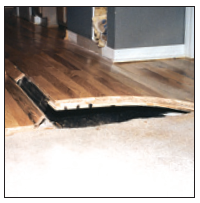What happened?
Buckled flooring has expanded beyond the allowable space that should be left at all obstructions (walls, thresholds, door casing/jambs, fireplaces, adjacent flooring). As a result it has nowhere to go but up, and has released from the subfloor.

Why has my floor buckled?
Buckling is caused by increased moisture. There are several possible sources?
- Inadequate expansion space at all obstructions.
- Excessive job site moisture from flooding, plumbing problems, relative humidity, or moisture present in other job materials such as plywood subfloors, concrete, paint/drywall compound, etc.
- Building without any or adequate HVAC operating.
- Grade/site slope directing water toward the structure.
- Inadequate/inconsistent fastening or improper adhesive/application.
What to do about buckling:
First, identify and address any moisture issues.
Identifying issues should not take long, but for moisture problems to dry thoroughly will take time. Only after that is completed should any attempt at repairing the floor be made. Provide expansion space at all obstructions and repair any flooring that has released from the subfloor as needed.
Other damage such as splits, cracks, and checks to the wood and/or finish and other symptoms of stress may also occur from the same stresses that caused a floor to buckle. Those boards may require replacement as well.
Is this a warranty issue?
The Somerset Limited Warranty excludes all site moisture related issues, including buckling, from coverage under the terms of the warranty.
FOR MORE INFORMATION, REFER TO THE NATIONAL WOOD FLOORING ASSOCIATION
(NWFA) Technical Publication No. C200, p.6